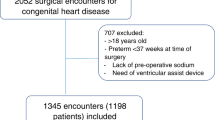Abstract
Dysnatremias (DN) are common electrolyte disturbances in cardiac critical illness and are known risk factors for adverse outcomes in certain populations. Little information exists on DN in children with cardiac disease admitted to the cardiac intensive care unit (CICU) after undergoing cardiac surgery, either corrective or palliative. The aim was to determine the incidence and adverse outcomes associated with DN in neonates and infants undergoing cardiac surgery. Retrospective cohort and single center study performed at Children’s Hospital Colorado from May 2013 to May 2014, in children under 1 year old admitted to the CICU after undergoing surgery for congenital or acquired cardiac disease. 183 subjects were analyzed. Exclusions: subjects that demonstrated DN before surgery. Serum sodium levels were recorded for the first 72 h post-operatively. DN was present in 54% of the subjects (98/183): hypernatremia in 60 (33%), hyponatremia in 38 (21%). Multivariate analysis revealed that mild hypernatremia (146–150 mmol/dl) and moderate hypernatremia (151–155 mmol/dl) were associated with longer hospital length of stay (LOS, p < 0.05) and ventilation times (p < 0.05). No association was shown between mild/moderate hyponatremia (125–134 mmol/dl) with either outcome. Hours to DN were significantly lower in hypernatremic (median = 5.8 h) than hyponatremic (median = 43.8 h) patients (p < 0.001). Children younger than 30 days presented DN at an earlier stage than those 31 days–1 year old (median +2.2 vs. 17.3 h). No associations present between DN and the class of diuretic (loop vs. thiazide) administered, or the route of administration (intravenous bolus vs. constant infusion). Total median sodium bicarbonate administration was associated with hypernatremia, as was exposure to vasopressin within the first 72 h post-operatively. Dysnatremias are common in the early post-operative period in neonates and infants undergoing cardiac surgery. Mild to moderate hypernatremia, but not hyponatremia, is associated with longer LOS and longer ventilation time in infants undergoing cardiovascular surgery. Hypernatremia is also associated with younger infants, a higher surgical complexity, administration of bicarbonate and exposure to vasopressin. Diuretic type or interval timing of intravenous delivery did not demonstrate any effect. Prospective studies are needed in this population, in order to determine how DN, particularly hypernatremia, contributes to adverse outcomes, whether this association is independent of illness severity, and what may be safe treatments and interventions for these disorders.

Similar content being viewed by others
References
Brouh Y, Paut O, Tsimaratos M, Camboilives J (2004) Postoperative hyponatremia in children: pathophysiology, diagnosis and treatment. Ann Fr Anesth Reanim 23:39–49
Darmon M, Diconne E, Souweine B, Ruckly S, Adrie C, Azoulay E, Clec’h C, Garrouste-Orgeas M, Schwebel C, Goldgran-Toledano D, Khallel H, Dumeni AS, Jamali S, Cheval C, Allaouchiche B, Zeni Z, Timsit JF (2013) Prognostic consequences of borderline dysnatremia: pay attention to minimal serum sodium change. Crit Care 17:R12–R20
Guarner J, Hochman J, Kurbatova E, Mullins R (2011) Study of outcomes associated with hyponatremia and hypernatremia in children. Pediatr Dev Pathol 14:117–123
Funk GC, Lindner G, Druml W, Metnitz B, Schwartz C, Bauer P, Metnitz PG (2010) Incidence and prognosis of dysnatremias present on ICU admission. Intensiv Care Med 36(2):304–311
Sakr Y, Rother S, Mendonca Pires Ferreira A, Ewald C, Dunish P, Riedemmann N, Reinhart K (2013) Fluctuations in serum sodium level are associated with an increased risk of death in surgical ICU patients. Crit Care Med 41:133–142
Stelfox T, Zygun D, Khandwala F, Laupland K (2010) Characterization of intensive care unit acquired hyponatremia and hypernatremia following cardiac surgery. Can J Anesth 57:650–658
Davalos MC, Barrett R, Seshadri S, Walters HL 3rd, Delius RE, Zidan M, Mastropietro CW (2013) Hyponatremia during arginine vasopressin therapy in children following cardiac surgery. Pediatr Crit Care Med 14:290–297
Ohuchi H, Nigishi J, Ono S, Miyake A, Toyota N, Tamaki W, Miyazaki A, Yamada O (2011) Hyponatremia and its association with the neurohormonal activity and adverse clinical events in children and young adult patients after Fontan operation. Congenit Heart Disease 6:304–314
Davidson J, Tong S, Hancock H, Hauck A, da Cruz E, Kaufman J (2012) Prospective validation of the vasoactive-inotropic score and correlation to short-term outcomes in neonates and infants after cardiothoracic surgery. Intensiv Care Med 38:1184–1190
Hoefer D, Ruttmann-Ulmer E, Smits JM, DeVries E, Antretter H, Laufer G (2010) Donor hypo- and hypernatremia are predictors for increased 1-year mortality after cardiac transplantation. Transpl Int 23:589–593
Luu R, DeWitt PE, Reiter PD, Dobyns EL, Kaufman J (2013) Hyponatremia in children with bronchiolitis admitted to the pediatric intensive care unit is associated with worse outcomes. J Pediatr 163:1652–1656
Heydarian F, Rezaeian A (2013) Relationship between changes in serum sodium level and seizures occurrence in children with hypernatremic dehydration. Iran J Child Neurol 7:35–40
Moritz ML, Ayus JC (2005) Preventing neurological complications from dysnatremias in children. Pediatr Nephrol 20:1687–1700
Topjian AA, Stuart A, Pabalan AA, Clair A, Kilbaugh TJ, Abend NS, Storm PB, Berg RA, Huh JW, Friess SH (2014) Greater fluctuations in serum sodium levels are associated with increased mortality in children with externalized ventriculostomy drains in a PICU. Pediatr Crit Care Med 15:846–855
Author information
Authors and Affiliations
Corresponding author
Ethics declarations
Conflict of interest
The authors have disclosed there is no conflict of interest with this study.
Rights and permissions
About this article
Cite this article
Kaufman, J., Phadke, D., Tong, S. et al. Clinical Associations of Early Dysnatremias in Critically Ill Neonates and Infants Undergoing Cardiac Surgery. Pediatr Cardiol 38, 149–154 (2017). https://doi.org/10.1007/s00246-016-1495-3
Received:
Accepted:
Published:
Issue Date:
DOI: https://doi.org/10.1007/s00246-016-1495-3




